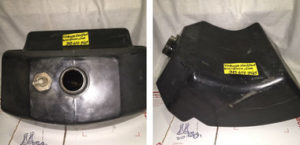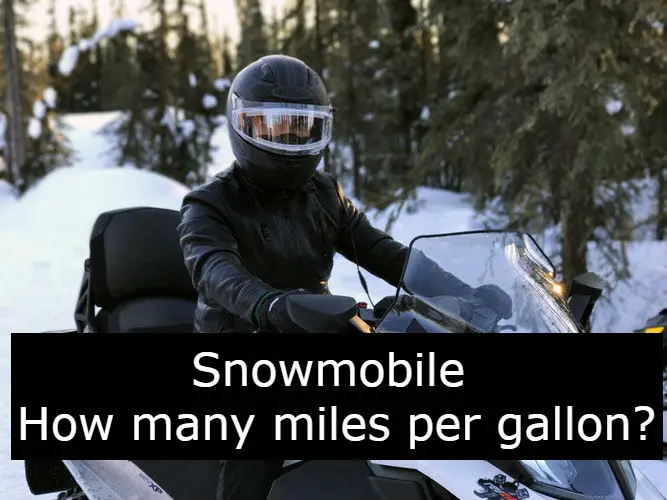Heading out into the wilderness on a snowmobile is one of the best things that you can do during winter. What you do not want to do though is get stuck in the wilderness because you ran out of gas. So how big is the gas tank on a snowmobile?
The average size for most tanks is around 10 US gallons (37.85 liters). How much use you can get out of those 10 gallons depends on how you ride. Full throttle will kill your miles to gallons figure but it is way more fun than riding conservatively.
Let us look at ten of the most popular snowmobiles and see how their tank sizes come in around the average size.
- Ski-Doo MXZ X 850 E-TEC, 9.5 US gal/ 36 liters
- Polaris 600 Rush Pro-S, 12 US gal/ 45 liters
- Yamaha Sidewinder L-TX LE, 10 US gal/ 37 liters
- Ski-Doo Freeride 850 E-TEC 165, 9.5 US gal/ 36 liters
- Ski-Doo Renegade Backcountry 850 E-TEC, 9.5 US gal/ 36 liters
- Polaris 600 Indy, 11.5 US gal/ 43.5 liters
- Arctic Cat ZR 8000 ES 137, 11.7 US gal/ 44 liters
- Polaris 800 PRO-RMK 155, 11.5 US gal/ 43.5 liters
- Yamaha Apex LE, 9.2 US gal/ 34 liters
- Ski-Doo MXZ TNT 900 ACE, 10.6 US gal/ 40 liters
What is my snowmobile’s miles per gallon?
By looking at these popular models, we can see that their average tank size is 10.5 US gallons; this tank size gives you roughly gives a range of about 300km (200 miles) and average fuel consumption of around 10-20 mpg. The Polaris 600 Rush Pro-S should be the snowmobile to grab if you want one with as large a fuel tank as possible. The size of the fuel tank though does not tell the full story of fuel consumption.
Four-stroke versus two-stroke
The engine on your shiny new sled will also affect your fuel consumption. Have you thought about the long-running two-stroke versus four-stroke debate? It is the kind of conversation that can spark fights in bars around the world.
There is probably no right or wrong answer to this, especially as technology is advancing fast, look at the new Ski-Doo Rotax 850 two-stroke engine, which is claimed to give four-stroke style durability. What you may find in the real world outside of magazine testing is that four-stroke engines provide a better fuel consumption figure in day to day use. This though is not the full story.
Have you thought about your body shape? That can affect your fuel consumption and use. If you are a lithe, skinny person, you may find that a lighter two-stroke sled is the best way for you ride, but if you are a big guy, that sled may have difficulty carrying you around. In that case, switch to a four-stroke with more torque and your sled will have an easier time and use less fuel.
More gas, more fun
Your fuel consumption as you can imagine is affected by many factors. If you want to extend the miles per gallon (MPG) that your snowmobile can get you probably do not want to spend time idling or riding about super aggressively. Always remember that the figure manufacturers give you will be based on conservative rather than aggressive riding and in ideal conditions.
Have you thought about storing your fuel? Storing fuel for longer than 30 days is a big no-no. You can get away with blended gasoline in a big engine, your car for example, but the smaller engine of a sled is not going to enjoy that. You will probably want to clean your tank out if it has sat for a month with fuel in it.
Keeping your fuel tank clean will also help maximise the amount of fuel that your snowmobile can use and stop you from carrying about a load of gunk at the bottom of your tank. You will want to remove and drain your fuel tank, remember and pay attention to all your local laws regarding this. The best place to start would be to drain your tank.
Deep snow vs little snow
This can also be a huge factor when looking at your miles per gallon value. Riding in deep snow can reduce your mpg with up to 40-50%. The engine is really stressed because snow will give a huge physical resistance. More gas more fun, remember?
Are you feeling drained?
Start by taking your tank cap off the sled, this should be an obvious step, but you will feel stupid if you forget it.
- Lift the back end of your sled up until it is around 2 feet off the ground.
- Now all the fuel should be collecting at the front of the tank.
- Pop a syphon into your tank and pop the other end into a bucket to collect the fuel.
- Start pumping that fuel out.
- Once the fuel stops flowing, disconnect the pump.
- Put your tank cap back on.
You have now drained your tank, but now you will need to empty it truly. This part is complicated so you might need to sit down for this. Take your keys and start your sled and run it until it stops. You will now have no fuel left in your tank. See I told you it was complicated. The next step to increasing your MPG is to remove the gas tank.

No need for removal men
Removing a fuel tank on a snowmobile is easier than you think it may be. My number one tip would be to have a look at your manufacturer’s parts schematic and that way you can see what connections need to be removed and where the bolts you need to take off are and even more importantly where they need to go back.
For most sleds, you will be removing your seat. Then the nuts holding your tank onto the snowmobile. Disconnect the fuel hose and fuel gauge wire. Then it is pretty much a case of lifting it and thinking “Wow, that was a lot less hassle than I thought”. You are now becoming a great mechanic. A little magnetic bowl would be a godsend for placing nuts and bolts in so you do not lose them in your garage, trust me putting them on the floor or workbench is the fastest way to lose them.
Clean on the inside, fast on the outside
Once your tank is removed, and you have made sure your nuts and bolts are all safe. You will want to put some ball bearings or small nuts in your tank. Pour in your favourite all-purpose cleaner, you can use special gas tank cleaners, they will do the same job but cost you more. Shake the tank, shake it again, put it down, pick it up and shake it again. Empty out your tank and leave it to dry.
Put everything back together, ideally so it in the reverse order of how you took it to pieces. You have now increased your fuel consumption.
How not to work on a snowmobile
While researching this article I came across a variety way in which people were not succeeding in removing their fuel tank. It is safe to say if you need to use an angle grinder, hacksaw, or a welder then at some point someone has not been doing their job properly.
So now you have a perfect example on how to not remove a fuel tank and a bit of guidance on how to do it. Take this information and keep your sled running longer and have way more fun out on the trails.
What is stopping you from becoming a home mechanic?
